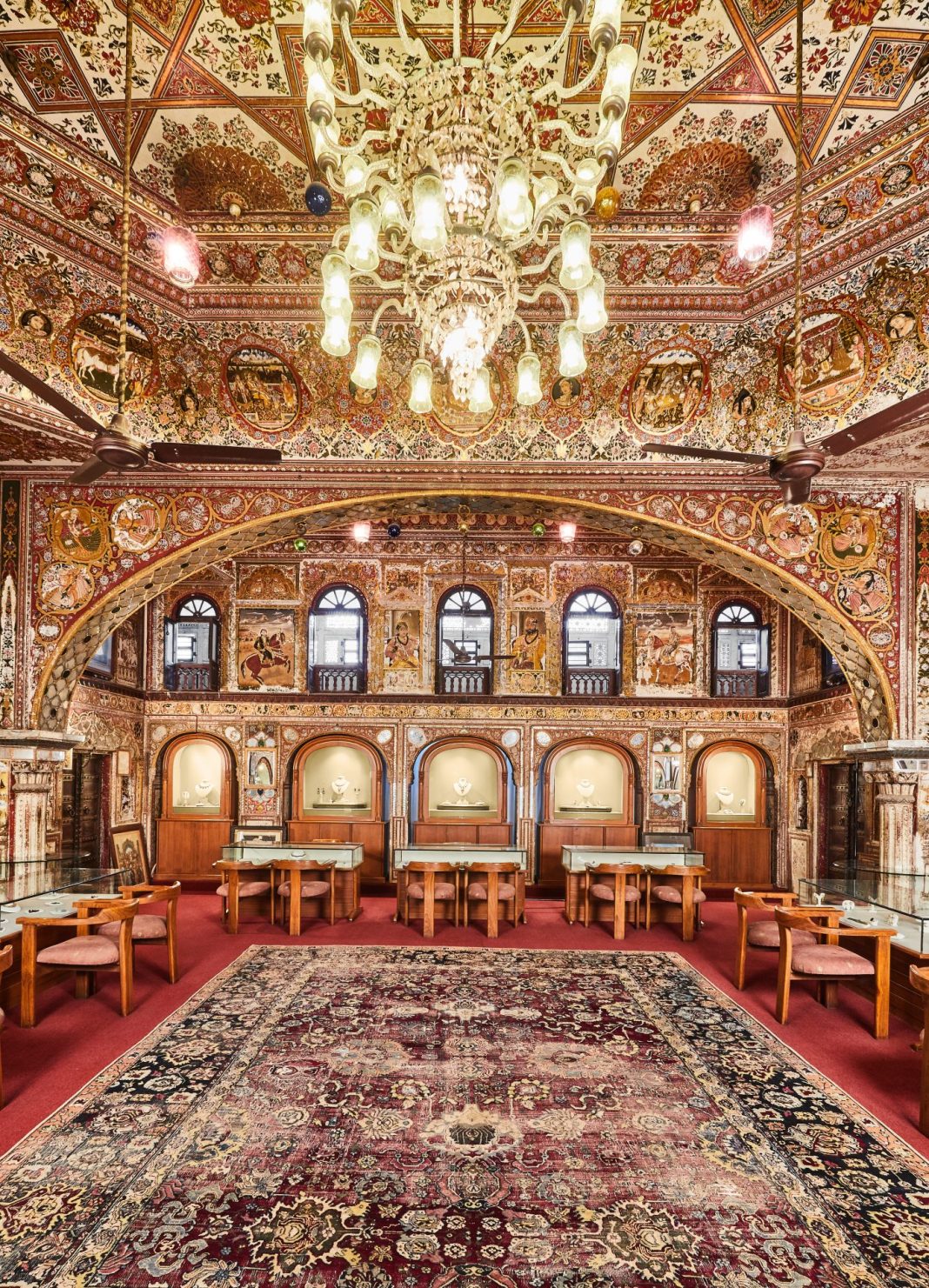Marvelling in a hushed awe at a Mughal-era star sapphire from Burma, Krishna Choudhary explained when you can tell a stone is valuable. ‘By colour, cut, carat, rarity, pureness’ is the professional answer. ‘But really, it’s when you start tearing up, and simultaneously get an urge to bite into it, that’s how you know.’ He held the 150-carat stone, a deep, translucent blue that snuggled into his palm. As he directed the light above it, the gem burst the light rays into six different ways. It was like opening your eyes underwater and looking up at the sun.
In a secluded eighteenth century mansion, the Saras Sadan Haveli, we found the headquarters for the Royal Gems & Arts in the old town of Jaipur. This residence has an opulent combination of bright colours from the Rajput Middle Ages and the remnants of Victorian inspiration, revealed by a well-preserved kaleidoscope of frescoes in natural pigments covering every inch of the walls and ceiling. However impressive these are, an equally dazzling treasure that lies within these walls is the Choudhary family’s jewellery collection. Krishna Choudhary, who is running the business alongside his parents Santi and Shobha, showed me a precious selection one by one, letting me handle each piece and relish each of their corresponding stories.
Jaipur became known as the “Pink City” when, in 1876, Maharaja Ram Singh had most of the buildings painted pink — the colour of hospitality — in preparation for Queen Victoria’s visit. Although the epithet of the city continues to bear a spectre of British colonial presence in India, there are locations in Jaipur that remain an authentic testament to its historical heritage intertwined with a tapestry of cultures, religions, and political identities. Central to this history is the Choudhary family, whose contributions to jewellery-making establish a legacy that underscores how gems and designs can hold cultural memory.
In 1727, the Hindu Rajput ruler Maharaja Sawai Jai Singh II moved the capital of Rajasthan to Jaipur, and invited Choudhary Kushal Singh to relocate to the new capital, bringing with him his knowledge and experience in financial and administrative matters. Over generations, they transitioned from minting coins for the royal authority to becoming the royal family jewellers. The labour-intensive pieces that they designed often served to bejewel the royal men, and less so the women, who were wrapped in the rarest colours and kinds of fabrics. Jewellery was a way to distinguish how important a person was, and the essence of Indian jewellery could be defined by the “more is more” aphorism. Photographic documentation of royals reveals how they always carried an impressive weight of valuable stones.
India’s rich culture of jewellery is partly a result of its geological advantages. The mines of Golconda, the earliest diamond mines known to man, are known to have yielded the highest grade of diamonds, Kashmir is known to have produced the rarest and most beautiful sapphires, and the greatest emeralds arrived to India from Colombia through commercial exchange via the Portuguese-controlled ports of Goa. Jewellery-making in India underwent a significant evolution in the Mughal period (1526-1761), when the craftsmen of the royal workshops welcomed Persian influences into the Indian artistic tradition, creating a style that came to define itself, even past the fall of the dynasty. When India came under British rule in 1858, the Mughal style endured and extended its influence on Western aesthetics and practices. Thereafter, as the family began thinking of showing their pieces to a global audience, the Persian carpets on which the business was conducted were replaced by glass vitrines. There are various design elements that make Indian jewellery quintessentially Indian. For instance, the traditional “kundan” technique, which involves setting stones in gold, as well as the “meena” technique with its intricate enamel painting are special to India. Furthermore, the execution of motifs like elephants, falcons, fish, lions, as well as the use of patterning and colour define the artistic tradition. Krishna founded Santi Jewels in 2019, and has since been creating designs that fuse the authenticity of these techniques with experimentation, giving some of the vaulted, age-old gemstones in the family’s collection beds to lie within contemporary renditions.
By incorporating uniquely Indian elements such as the jaalis – architectural ornamental openwork screens – into contemporary designs, Krishna, as the 10th generation jewellery maker from his family, marries the rarest gems with the most intricate craftsmanship available today.


